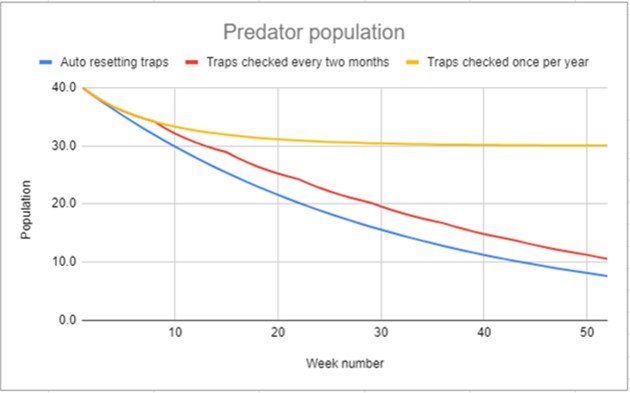Will automatic resetting traps make much of a difference to our ability to totally eliminate predators?
Today we return to our core subject of eliminating predators. If you're keen to follow our work on the fever screening device (which is now on the market), we have now launched a new website with its own blog: http://www.tekahuora.com. All future updates on the device will appear there.
So, back to dealing with predators. In some previous blog posts, we showed how a simple model can help understand typical trapping and poisoning methods.
Part of the goal of this model was to help understand what strategies might make the biggest difference and thus improve the chance of total predator elimination. In this blog we discuss the predictions our model makes on the impact of auto-resetting traps.
The short summary of that is that predators show a very low interaction rate with traps (see video).
Auto-resetting traps
A number of organisations are working on auto-resetting traps and we applaud that work as it makes a lot of sense in terms of labour saving. Remember our goal here at The Cacophony Project is elimination of predators so today we want to understand just how much impact traps like these make to the resident predator population.
See this previous blog entry for a specific experiment we carried out involving two of the most popular self resetting traps. Those findings seem to confirm that, as with most current traps, the normal predator behaviour is to walk past without interacting with the trap.
As usual, just to make sure we're all talking about the same thing, a couple of definitions:
Auto-resetting trap: A trap that, once triggered, will reset itself without help from a human, so remains ready to trap another predator.
Manual trap: A trap that, once triggered, must be reset manually. Until it is reset, this trap is out of action (we often refer to this as a "closed" trap).
Referring to the graph below:
the blue line shows the population trend for an automatically resetting trap
the orange line represents manual traps checked once a year
the red line represents manual traps checked every 2 months
As expected, in the case of manual traps, the more often they are checked and reset the more often they will catch predators. The interesting thing here is when we look at the overall catch rate of the auto-resetting trap. Intuitively, we might expect it to be substantially higher.
You may find yourself a bit surprised to note that the auto-resetting trap has only done a little better than the manual one checked regularly. So the auto-resetting trap is saving effort but not making a big difference in knocking down the predator population.
Note: Get your own copy of the model here. For an explanation of how the model works, please refer back to this blog entry.
If you are interested in lowering the cost of suppression through less labour, then auto-resetting traps will certainly help. However, there is no dramatic reduction in predator numbers compared to using manual traps. Our model shows that the reason it doesn’t make much difference is that a very large proportion of predators just walk on by existing devices.
Automatic resetting will be important if a high interaction trap can be designed but automating something predators don’t interact with very often doesn’t look like a very good strategy for full predator elimination.
As always, we welcome your feedback so don't hesitate to get in touch - leave a comment below or email us at blog@cacophony.org.nz.


